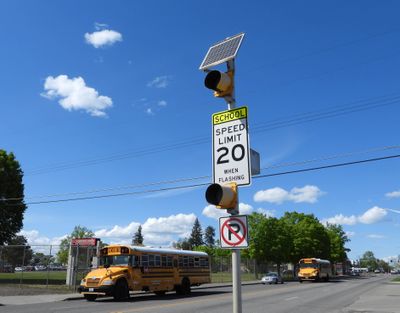Getting There: Spokane speed cameras turn on Tuesday, now with cheaper tickets

Spokane’s ticket-issuing speed cameras, all of which are located near schools, will turn on Tuesday with the first day of a new school year.
There are eight speed cameras covering streets near Lidgerwood, Finch, Ridgeview, Willard, Adams and Roosevelt elementary schools, as well as Ferris High School. The cameras, placed near schools with the intent to reduce speeds and the risk of collisions involving children, are active for roughly 30 -minute windows before and after the school day and issue tickets for anyone caught going more than 8 mph over the speed limit.
Despite this limited time frame and window of speed that triggers a ticket, thousands of drivers each year still manage to get one of those tickets.
In May, when one of the eight cameras was down for repairs, 2,221 tickets were issued for drivers speeding near schools, down from over 3,000 in May 2023. In the first six months of the year, these speeding tickets generated more than $1.9 million in revenue, the city’s portion of which must go to the dedicated Traffic Calming Program, which is traditionally used to pay for speed-reducing infrastructure like roundabouts or speed humps.
While the tickets can be costly, new state legislation this year will reduce some of the fines significantly. Before June, speeding tickets could cost anywhere from $217 to $450 per violation; the new law capped camera ticket prices at $145 in most areas and up to $290 in school zones, though Spokane will only be charging $250 at most, said Sgt. Teresa Fuller, who works in the police department’s traffic unit.
“We don’t put the cameras in to generate funds,” Fuller said. “We put them in to prevent collisions.”
The new state law also allows the penalty to be cut in half if the violator is a recipient of most forms of state public assistance.
Aware of criticism that traffic tickets disproportionately burden poorer residents, Spokane Mayor Lisa Brown said in a Friday interview that she understood the state Legislature’s motives for making the changes.
“Particularly given lower income in our city, I’m not concerned (by the changes),” she said. “I think the deterrent is still there when you get a ticket.”
The city also maintains 10 red -light cameras throughout the city and has plans to expand to at least two more in the short term, with the usual slow timeline for expansion cut short by Brown’s Safe Streets executive order in July.
The new law also widely expanded where cities can place their ticket-issuing traffic cameras, allowing them to be placed on sections of state routes that pass through city limits, areas designated by the city or county as having higher crash risks, and in work zones.
The law allowed for a number of other new uses for the cameras, such as detecting cars that don’t stop before crosswalks or traveling in bus-only lanes, but these provisions are only allowed in a city with more than 500,000 people, meaning only Seattle qualifies.
Brown said she believes expanding the city’s use of traffic cameras is merited, a sentiment supported by a majority of the Spokane City Council.
“But I don’t think speed cameras alone are – they’re a tool in a larger framework to improve bike and pedestrian safety and reducing traffic accidents,” Brown said. “Obviously I want to see the crash data, but I personally think wherever there are children, like parks and schools, let’s look at implementation.”
The Spokane City Council pushed for a major expansion of the city’s speed cameras in 2022, prompted by a two-year pilot program that lowered the speed limit to 20 mph on larger roads bordering parks year-round, rather than just during the summer. The study found that lower speed limits and signage didn’t prevent drivers from speeding in those areas.
At the time, then-City Council President Breean Beggs argued speeding cameras may be needed to slow drivers down, particularly because the Spokane Police Department’s dedicated traffic enforcement patrol unit was disbanded the year prior.
Brown recently relaunched that traffic unit, with four traffic officers assigned to this task, though this is still fewer than before the unit was disbanded in 2021.
In late 2022, the council looked to more than double the number of speed cameras to 20, taking advantage of a then-new law allowing them to be placed around parks and hospitals.
But the city couldn’t simply install new cameras without having to go through time -intensive steps, Fuller said. Despite frequent concerns from neighborhood councils asking for cameras in areas they believe should be a priority, crash data often hasn’t backed up those suggestions, she said.
“We try to be very active in how we select those locations; we’re looking at crash data, speed, talking to schools and school crossing guards,” she said. “It typically takes from six months to a year to get a camera in.”
Fuller said she was currently more focused on expanding red -light cameras, noting there were a handful of intersections where crash data suggested they were most needed. A speed study around schools is also scheduled once the school year begins, she added.
Cities or counties must conduct an analysis of an area before installing a new traffic camera showing a need for the new camera based on “vulnerable road users” such as children, evidence of frequent speeding or collisions, and a report showing other traffic safety measures would not be feasible. Crash data for areas where cameras are installed must be posted by a city or county annually.
The city of Spokane also will be required by the new law to invest a portion of its traffic calming funds into poorer areas of the community with high crash rates.